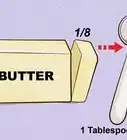This article was co-authored by wikiHow Staff. Our trained team of editors and researchers validate articles for accuracy and comprehensiveness. wikiHow's Content Management Team carefully monitors the work from our editorial staff to ensure that each article is backed by trusted research and meets our high quality standards.
This article has been viewed 113,394 times.
Learn more...
To julienne a vegetable means cutting it into thin, uniform matchsticks. It's important to always wash your vegetables and utensils first. You'll cut round vegetables into a rectangle, chop into the proper length, and slice them into pieces of uniform thickness. You can also perform a slightly different julienne method for onions.
Steps
Cutting Julienne Matchsticks with a Knife
-
1Wash the knife, cutting board, and vegetables. Clean the knife and cutting board with hot water and soap, and be sure to rinse both off thoroughly. Your vegetables don't need to be washed with soap, but rinse with hot water and consider scrubbing with a cloth or brush.
- Use a sharp, non-serrated knife for cutting. A chopping knife works well but is not required. It's important to only use a sharp knife so you can make clean cuts.
-
2Peel the vegetable if you want to. Potatoes and carrots are often peeled before being julienned. It is up to you depending on how you plan to eat them. If you don't peel your potatoes, at least make sure buds or eyes are removed from the skin.[1]
- Use a peeler or a paring knife to remove the skin.
Advertisement -
3Cut rounded vegetables into a rectangle. Cut off the stem and bottoms when necessary. Slice off one side at a time so you are left with a rectangular chunk of vegetable. You can throw the scraps away, or you can slice them up and mix them in with the uniform pieces you'll cut later.[2]
- This is especially helpful for potatoes, zucchini, and squash.
-
4Chop the vegetable into chunks that are 2-3 inches (5-8 cm) long. If you are going to be eating the pieces raw, they can be a little longer, but if you're cooking with them, 2-3 inches is best. Each chunk does not have to be the exact same length, just divide the vegetable evenly.
- The general rule for juliennes is that you'd be able to eat them in one bite, but you can cut them into longer chunks if you want.
-
5Slice the vegetable down the length. When cutting juliennes, ⅛ in (0.3 cm) to 1/16 in (0.15 cm) is the recommended thickness. Use the knuckles of the hand not holding the knife as a guide for the thickness.
- Be careful not to cut yourself as you slice.
-
6Stack 2-3 slices and cut again. Flip the slices you've just cut so that they are piled on top of each other. Then cut them into sticks that are ⅛ in (0.3 cm) to 1/16 in (0.15 cm) thick, again. The goal with juliennes is to get them all to a fairly uniform size.
Cutting Onions with a Knife
-
1Remove the top and tail portions. The stem and tail pieces aren't needed for juliennes, so cut them off and throw them away. You can also peel off the outer skin layers of the onion so that you have just the flesh left.
- Onions tend to be a little firmer than many other vegetables, so make sure your knife is sharp before you start. A dull knife will make the process much harder.
- Make sure the top and bottom are chopped off in a nice smooth cut.
-
2Cut the onion in half. Since onions are generally about the size that you want julienne sticks to be lengthwise, there is no need to cut an onion into a rectangle or into chucks. Simply cut it in half from top to bottom.
-
3Slice diagonally toward the center of the onion. With the onion laying flat side down, slice at an angle so that pieces stay at a uniform thickness. As you near the halfway point, your knife should be at 90 degrees. Flip the onion on its side and continue cutting.[3]
- Perform the same process with the second half of the onion.
Using a Mandoline Slicer
-
1Set up the mandoline on a sturdy surface. Some mandolines have a container to catch the food as it is sliced, but if not, make sure you have a container under it. Set the mandoline on your cutting board, or on the counter or table, and be sure it will not slide around as you slice.
-
2Choose your blade and set the thickness. Different models will have different options. If yours has multiple blades, then pick which is best for what you are cutting. If your mandoline has adjustable thickness, then set it to where you want it to cut.[4]
- If you don't know exactly how the blades will cut, grab a potato and try out each blade so you can figure out when you'll want to use which blade.
- You can also test out the various thickness settings so you can see what works best for the dish you are planning to make.
- Mandoline blades are incredibly sharp, so always handle carefully.
- Besides thickness, the blades may also cut in a specific pattern or texture, which is important to know ahead of time. If you want matchsticks but you have a waffle cut blade, you're not going to get what you want.
-
3Cut the fruit or vegetable into smaller chunks. Most mandolines won't fit an entire cucumber, large potato, or whole onion. If the piece you are going to slice seems too big for the mandoline, cut it into smaller chunks that will fit better.[5]
-
4Secure the fruit or vegetable to the hand guard. The hand guard is not an optional piece of the mandoline, so don't take it as such. Always secure the piece of food to it before you begin cutting. As you cut, pay attention to where your fingers are so they never get too close to the blade.[6]
- Even with the hand guard, it's possible for your fingers to slip off it toward the blade, so always be careful and watchful of where your fingers are.
-
5Move the fruit or vegetable back and forth quickly over the blade. Mandolines work best when you slice quickly, and their sharpness is designed for this. Don't go so fast that you rock the mandoline back and forth, but you don't need to go slowly.
- Pay attention to where the slices fall to make sure they don't stack up so high that they block the blade, which could cause you problems.
- Keep your hand tight on the hand guard as you slice.
Community Q&A
Did you know you can get answers researched by wikiHow Staff?
Unlock staff-researched answers by supporting wikiHow
-
QuestionDo I need to peel carrots before julienning them?
 wikiHow Staff EditorThis answer was written by one of our trained team of researchers who validated it for accuracy and comprehensiveness.
wikiHow Staff EditorThis answer was written by one of our trained team of researchers who validated it for accuracy and comprehensiveness.
Staff Answer wikiHow Staff EditorStaff AnswerThis will depend on what the recipe requires but it is usual to peel the carrots first, then julienne them. Use a vegetable knife or peeler to peel the carrots.
wikiHow Staff EditorStaff AnswerThis will depend on what the recipe requires but it is usual to peel the carrots first, then julienne them. Use a vegetable knife or peeler to peel the carrots. -
QuestionAre using mandolines helpful when you are julienning?
 Community AnswerMandolines are a great help! They reduce the work and ensure precise and uniform cuts.
Community AnswerMandolines are a great help! They reduce the work and ensure precise and uniform cuts.
Things You'll Need
- Cutting board
- Peeler
- Knife
- Fruit or vegetables
- Mandoline
- Container for sliced pieces
References
- ↑ https://www.leaf.tv/articles/how-to-julienne-vegetables/
- ↑ http://www.cooksinfo.com/julienne
- ↑ https://stellaculinary.com/cooking-videos/culinary-knife-skills/cks-007-how-julienne-onion
- ↑ http://www.thekitchn.com/get-the-most-out-of-your-mandolin-tips-and-techniques-189300
- ↑ http://lifehacker.com/four-tips-for-mastering-the-mandoline-slicer-1776572570
- ↑ http://www.dummies.com/food-drink/cooking/kitchen-tools/how-to-use-a-mandoline-to-slice-vegetables/
About This Article
To julienne a vegetable, start by cutting off any rounded ends with a knife to make the vegetable rectangular. Then, cut the vegetable into bite-size segments. Next, take each segment and slice it into thin strips lengthwise. Finally, re-stack the strips and cut them again to make long, thin sticks. If you want to learn how to use a mandoline to slice your vegetables, keep reading the article!

















































